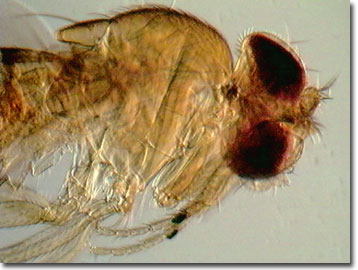Oblique Digital Image Gallery
Fruit Fly (Drosophila melanogaster)
The cornerstone experimental animal in the study of cellular and molecular genetics for over 50 years has been the ubiquitous fruit fly (Drosophila melanogaster). Whether mutated to a wingless, white-eyed, or barred, phenotype, or wild, it is the fruit fly that each budding geneticist is first exposed to. More recently, Drosophila are playing a starring role in developmental biology with particular emphasis on this dipteran's embryonic stages. Because they are easy to feed, breed, and maintain in a laboratory setting and their two-week life cycle is relatively short, fruit flies will certainly continue to shine as experimental specimens. This includes the newer fields of gene therapy and genetic engineering as the map of the Drosophila genome is completed.

View a second image of a fruit fly.
Outside of the laboratory, fruit flies, as their names imply, feed on bacteria and yeast found in decaying or damaged fruit and vegetables, including commercially important crops. As an agricultural pest, these tiny flying insects can ruin strawberries, tomatoes and bananas as well as succulents such as cacti with their numerous eggs and larvae. In Hawaii, many of the 1,000 or so native Drosophila species are declining due to habitat destruction and introduction of non-natives. After their introduction from Europe to the Chile in 1978, Drosophila subobscura spread throughout the Chilean coast and have since displaced most of the native D. pseudo-obscura along the North American Pacific Coast, all the while evolving at an alarmingly rapid rate. The Japanese water lily creates a natural alkaloid that is toxic to D. melanogaster, but synthesized insecticides and traps are used as commercial controls. Other species of flies bearing the common name "fruit fly", such as the Mediterranean fruit fly or Mexican fruit fly, are also agricultural pests, but are not closely related to Drosophila.
As with other members of the order Diptera (the true flies), the fruit fly starts its life cycle as an egg that is about 0.5 millimeters long. At 25 degrees Celsius (room temperature), a day after fertilization of the egg, the embryo develops and hatches into a worm-like embryo. The feeding larva grows and molts three times, and by the fourth day of life, has reached the third instar stage. Two days later, the larva molts into an immobile pupa and after four days of development, emerges in its adult winged form. A day later, maturity is achieved and the life cycle is ready to replay. At 18 degrees Celsius, development may take twice as long.
Contributing Authors
Cynthia D. Kelly, Thomas J. Fellers and Michael W. Davidson - National High Magnetic Field Laboratory, 1800 East Paul Dirac Dr., The Florida State University, Tallahassee, Florida, 32310.
BACK TO THE OBLIQUE IMAGE GALLERY
BACK TO THE DIGITAL IMAGE GALLERIES
Questions or comments? Send us an email.
© 1995-2025 by Michael W. Davidson and The Florida State University. All Rights Reserved. No images, graphics, software, scripts, or applets may be reproduced or used in any manner without permission from the copyright holders. Use of this website means you agree to all of the Legal Terms and Conditions set forth by the owners.
This website is maintained by our
Graphics & Web Programming Team
in collaboration with Optical Microscopy at the
National High Magnetic Field Laboratory.
Last Modification Friday, Nov 13, 2015 at 01:19 PM
Access Count Since September 17, 2002: 8941
Visit the website of our partner in introductory microscopy education:
|
|
